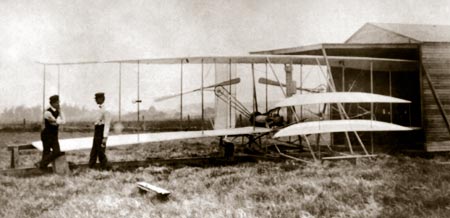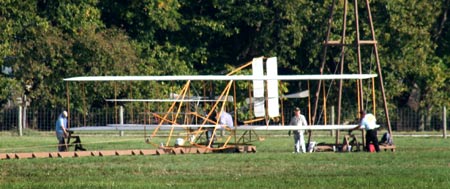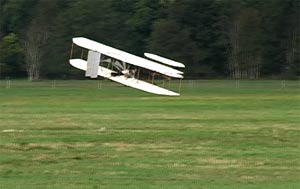
Huffman Prairie Field
Huffman Prairie Flying Field was designated a National Historic Landmark for its role in the development and testing of the world's first practical airplane, the Wright Flyer III. Huffman Field, touted by some as the cradle of aviation and the world's first aerodrome, is the flying field where Wilbur and Orville Wright obtained the necessary practice and experience to master the principles of flight.

Huffman Field at the time of the Wright brothers, was a 100-acre farm meadow used for livestock owned by Torrence Huffman. Huffman gave the wrights access to the field, but had little faith in their flying contraption. "They're fools," Torrence told a local farmer. Back in Dayton, the Wrights turned over their bicycle shop to Charlie Taylor to run while they concentrated all their efforts at developing their flying machine.
The Wright brothers began their flying experiments here and constructed a hangar for that purpose. After their successful first flight in Kittyhawk, North Carolina, they decided it would be better and less expensive if they could work on their flying machine closer to home. The answer was Huffman Field. Because the winds in southwest Ohio were far less predictable than those in Kittyhawk, they devised a contraption to help give them the necessary lift to obtain lift off without the aid of wind. This same principle they developed, is still used today on aircraft carriers.

 Being able to work on their airplane in Dayton, and then test it in nearby Huffman field, they were able to quickly make substantial improvements in the design of their plane. With the improved aircraft, they learned to turn, bank, and fly figure-eights as well as circles. In the longest flight of that season, Orville remained aloft for 39 minutes, 23 seconds on 5 October 1905, making 29 circuits of the site. Replicas of the 1905 hangar and the catapult launch device now stand on the site.
Being able to work on their airplane in Dayton, and then test it in nearby Huffman field, they were able to quickly make substantial improvements in the design of their plane. With the improved aircraft, they learned to turn, bank, and fly figure-eights as well as circles. In the longest flight of that season, Orville remained aloft for 39 minutes, 23 seconds on 5 October 1905, making 29 circuits of the site. Replicas of the 1905 hangar and the catapult launch device now stand on the site.
Once the Wright brothers were satisfied they had a workable design, they quit flying at the field. Their activities were starting to draw crowds of onlookers that were arriving from across the country. Being accomplished businessmen, they wanted to protect their invention from being copied by others. So after their successful 1905 season, the brothers suspended flying at Huffman Prairie while they pursued acquiring patents for their inventions.
The Huffman Flying Field would later become part of Wright-Patterson Air Force Base. Wright-Patterson was named after the Wright brothers, and Frank Stuart Patterson, son and nephew of the co-founders of National Cash Register. Frank Patterson was killed on June 19, 1918, in the crash of his Airco DH.4 at Wilbur Wright Field.
Video replica Wright Brothers Flyer III at
Huffman field on October 5, 2007
Huffman Prairie Field Today
The development of the Huffman Prairie Field resulted from a successful grassroots effort that grew from the work of Aviation Trail Inc., a local non-profit organization established in 1981 to preserve and promote Dayton's unusual aviation heritage. Later, a National Park Service study of some of these historic properties resulted in their designation as national historic landmarks.
Today the park is a partnership among federal, state, and local governments as well as the private sector to preserve and interpret the historic structures and districts associated with this area. Occasionally, a reproduction of the Wright Flyer III is flown at the field.

The Wright Brothers Shed
At the east end of the flying field is a reconstructed wooden shed, similar to the ones the Wright brothers used. The low, wooden gable-roofed shed was converted into a livestock shelter in the winter of 1904 and torn down thereafter. A larger hangar was constructed in 1905 and replaced in 1910 when the Wrights built a new one near the intersection of the Yellow Springs and Springfield Pike for the Wright Company. The flying field is actually on Wright Patterson Air Force base, and it shares the area with other Air Force activities. The field is accessible most of the time.

The Wrights developed a derrick and weight launching system and positioned it on Huffman Field in 1904; this system rolled planes down a short launching rail. In 1910 the Wright brothers replaced this system with the use of airplane skids. Although previously operating a winter flying school in Montgomery, Alabama, Orville Wright, the principal instructor of the school, moved the permanent operations to Huffman Field in 1910. Among the most notable students trained at Huffman were Lt. Henry H. "Hap" Arnold, Commander of the U.S. Army Air Corps in World War II; Griffith Brewer, the first Englishmen to fly an airplane; Cal P. Rodgers, the first person to fly across the United States; A. Roy Brown, the pilot who shot down the Red Baron during World War I; and three daring women: Rose Dugan, Mrs. Richard Hornsby and Marjorie Stinson. Today the terrain has changed little since the Wright brothers used Huffman prairie.
Anniversary recreation
Huffman Field 100th Anniversary commemorating, Wilbur Wright's flight that made practical flight possible on October 5, 1905, took place in 2005. The 102nd Celebration of toke place at Huffman Prairie Flying Field the week of October 1 through 5, 2007. This celebration also commemorated Wilbur Wright's flight of October 5, 1905. The week- long series of events, sponsored by the National Park Service, was open to the public and was highlighted by a visit from Russia's ambassador to the United States, Yevgeny Zvedre, on the morning of October 5.
Coinciding with the Celebration of Practical Flight was the 50th anniversary of Russia's launch of Sputnik, the first successful man-made satellite put into space, on October 4, 1957. Commemorating these two international milestones, the Russian ambassador to the United States visited Dayton on October 4 and 5. A dinner was held at Carillon Historical Park on October 4 and the Huffman Prairie flight on October 5 were the two highlights of the visit.



The flight on October 5, 2007 was similar to one the Wright brothers experienced. Mark Dusenberry, an ODOT engineer and builder of the reproduction Wright Flyer III found out the hard way Friday morning at Huffman Prairie Flying Field. As a crowd of more than 2,000 people gathered to celebrate the 102nd anniversary of the Wright Flyer III.
Dusenberry flew about 15' above the ground for a total of about 30 seconds. As he entered a slow, gentle bank, one of his wings scraped the ground and the replica flyer promptly packed it in. Dusenberry was unhurt but disappointed in the results. "This is the most damage I've ever had," the Ohio Department of Transportation Engineer said.


